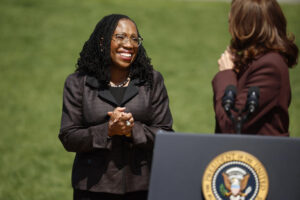JANUARY 1, 2023

Marissa Vonesh/Washington Post Illustration; Robin L Marshall/Getty; Kevin Dietsch/Getty; Gareth Cattermole/Getty; Bennett Raglin/Getty; Mason Poole/A.M.P.A.S./Getty; iStock; Pexels; Unsplash); Kevin Dietsch/Getty;
It’s understandable that people might feel tentative about charging boldly into the new year. After all, the 2020s haven’t offered a surplus of cheer so far. And blind optimism isn’t exactly doing the trick when it comes to lifting us out of a funk.
Still, there’s always a glimmer of something worth noticing in a new trend, a stray statistic, a shift in thought. Here, seven writers offer some concrete examples of things that might actually improve in 2023.
Black women will continue to rise
By Robin Givhan | After the votes were finally counted in the 2022 Los Angeles mayoral race, Rep. Karen Bass (D-Calif.) made history, becoming the first Black woman elected to run the country’s second most populous city. While Black women were dealt political losses — Val Demings, Stacey Abrams — voters in the nation’s capital reelected Muriel E. Bowser (D) to a third mayoral term and Black women continue to lead San Francisco, New Orleans, St. Louis, Chicago and Charlotte.
In remarks to her supporters, Bass acknowledged the enormity of her victory as well as her responsibility: “You have to think that the path that you go [on] is laying the foundation for those that come behind you.”

Judge Ketanji Brown Jackson smiles as Vice President Harris speaks at an event celebrating her confirmation to the Supreme Court on the South Lawn of the White House on April 8. (Chip Somodevilla/Getty Images)
Optimism is the belief that not only will other Black women follow Bass, but they will also excel in new and even more profound ways.
There’s reason to be optimistic about the trajectory of Black women thanks to the investiture of Ketanji Brown Jackson to the Supreme Court. The evidence isn’t simply that she made history, but how it unfolded. A sisterhood of successful Black friends and former classmates — Antoinette Coakley, Lisa Fairfax and Nina Simmons — publicly bore witness to Jackson’s trail of achievement. Cory Booker (D-N.J.), the only Black senator on the Judiciary Committee, lifted Jackson up with his praise and encouragement in the midst of her contentious confirmation hearings. Jackson’s daughter, Leila, gazed at her mother with stirring pride from the visitor’s gallery. And Jackson herself sat before the committee on her own terms, with her hair in braids, her smile wide and her intellect blazing.
Popular culture also offers reasons to feel good about Black women in 2023. Viola Davis not only portrayed the fearless lead character in “The Woman King,” but she was also a producer of the film, which was based on a true story. She recounted her own difficult history in a critically acclaimed memoir, “Finding Me.” In her work, Davis is helping to write a new history of all Black women. The future is also tilled by the record-setting Grammy nominations of Beyoncé, the critical success of designer Grace Wales Bonner, the artistry of Amy Sherald in London and Mickalene Thomas in Paris and Deana Lawson in New York.
Progress isn’t always a straight line. But from 2022 to 2023, optimism is a through line.
Robin Givhan is The Washington Post’s senior critic-at-large.
The relationship economy will thrive
By Anne-Marie Slaughter | The year 2023 will see the continued growth of the relationship economy: interesting, decently-paid jobs for coaches, navigators, guides, advisers, mentors, teachers and therapists of every description. These jobs use data and different technologies to ensure that the guidance offered is tailored and effective, but they depend almost entirely on the quality of connection between two human beings. They are thus hard to automate; on the contrary, they increasingly require certifications of various types that support salaries well above minimum wages. (According to salary.com, the average wage for a health and wellness coach in the United States is $62,847.)
As we come to recognize the essential role of these jobs in a thriving economy and society, we should also be able to raise the wages and the value assigned to the most fundamental relationships of all: the connection between caregivers and those they care for — our children, seniors and other members of our families and communities who are ill, disabled and vulnerable. Writing about quantum physics and the ways it has transformed our understanding of our world, the Italian physicist Carlo Rovelli observes: “We understand reality better if we think of it in terms of interactions, not individuals. We, as individuals, exist thanks to the interactions we are involved in.” As individuals, and slowly, as a species, we are coming to understand that our relationships to one another and to our planet determine whether we flourish or fail.
Anne-Marie Slaughter is the CEO of New America and the author of several books, including “The Chessboard and the Web: Strategies of Connection in a Networked World.”
Moms are moving past perfectionism
By Helena Andrews-Dyer | Momming is so hard. That shouldn’t be breaking news. The act of mothering children — small, medium, and adult-size — has been difficult since the beginning of time. And yet for each new generation of parents, the reality of being responsible for tiny humans hits different. Enter the social media mom, an Instagram-filtered figure who gently reigns over a house filled with Montessori toys that never clutter the all-white living room, whose children eat broccoli without complaining.
Those ever-present images of magical momming polluted parenting culture, giving the rest of us normie mommies a stomach ache. But thankfully the lies (er — stories), we’ve been telling ourselves are getting real. There’s a new crop of books coming that sets fire to the perfect mom fantasy.
Journalist Jessica Grose’s new tome, “Screaming on the Inside: The Unsustainability of American Motherhood,” seeks to counter “momfluencer” culture by uncovering mom guilt for what it really is: an obvious response to impossible standards. Then there’s Sara Petersen’s “Momfluenced,” which peels back the layers of performance parenting. In “She Bad: Tales of Love, Hate and Baby Motherhood,” culture critic Jamilah Lemieux plans to offer up a part memoir, part manifesto on both Black motherhood and a single motherhood. All these pages (including my own 2022 book, “The Mamas: What I Learned About Kids, Class, and Race From Moms Not Like Me”) are forming a new canon of modern motherhood. Collectively, we’re sending a message, hoping to lift the burden off mothers of the future.
Helena Andrews-Dyer is a pop culture writer for The Post.
Opioid deaths could start going down
By Courtland Milloy | Researchers at Harvard and MIT have built a systems model that predicts that the U.S. opioid crisis might soon peak, perhaps as early as 2023, and abate by 2030. There were, however, two scenarios: one they called “optimistic,” and the other “pessimistic.” I would like to take the optimistic view, in which nearly 300,000 lives would be saved over the next seven years.
That outcome requires removing obstacles that physicians face in providing buprenorphine to opioid-addicted patients, increasing the availability of overdose reversal agents such as Narcan and increasing overdose prevention devices such as fentanyl test strips. Such efforts are underway and, thanks to more money for drug treatment included in President Biden’s recently passed federal budget, they have a chance of making an impact in the new year.
The Harvard model cites community support as a key component of recovery from drug addiction. I believe that as the coronavirus pandemic continues to subside, that kind of support — especially from faith-based organizations — will become more available.
Another factor in favor of the optimistic outcome is “risk perception,” whereby the prevalence of overdose deaths begins to discourage certain people from experimenting with drugs. A record 107,000 people died from drug overdoses in 2021. Sadly, that might be what it takes to make a teenager say no to a fatal dose of fentanyl disguised as a party pill.
The optimistic scenario does not mean an end to drug overdose deaths between now and 2030 — just 300,000 fewer than the 842,000 fatalities forecast under the pessimistic, do-nothing scenario. Still, a life saved is a life saved. That’s not just optimistic. That’s realistic.
Courtland Milloy is a local columnist for The Post.
We’ll have more Latinx superheroes

Diego Luna attends a special launch of “Andor” on Sept. 15, 2022 in Los Angeles. (Momodu Mansaray/Getty Images)
By Jorge Ramos | When I first arrived in the United States, exactly 40 years ago, the undeniable hero of the Latino community was Cesar Chavez. The farmworkers’ leader embodied the dignity of our culture and the aspirations for a better future. Fast-forward to 2023, and the new superheroes are Cassian Andor and Namor — respectively from the Star Wars prequel series and the Marvel Studios movie “Wakanda Forever” — played beautifully by Mexican actors Diego Luna and Tenoch Huerta.
After Chavez’s death in 1993, we realized we needed 1,000 leaders to replace him, not just one. And now we have Justice Sonia Sotomayor, astronaut Frank Rubio, writer Sandra Cisneros, Bad Bunny (the most streamed artist in the world), Los Angeles Philharmonic Director Gustavo Dudamel, humanitarian chef José Andrés and a record-breaking 45 members of Congress, including 25-year-old Maxwell Alejandro Frost.
I see new Latinx superheroes everywhere. And eventually a presidenta.
At 62 million, we’re the largest minority, and we’re unstoppable. We have gone from big numbers to power. And power is measured in representation and participation. Even in streaming series and home runs. Cesar Chavez once said: “We have looked into the future and the future is ours.”
He was talking about us, now. He would be proud.
Jorge Ramos is a senior news anchor at Univision News.
Pay transparency is catching on
By Michelle Singletary | More than 20 years ago, a co-worker cornered me in the newsroom and whispered what she was earning on an annual basis. She waited for me to do the same. It was an uncomfortable second or two before I said: “I can’t share such information. So sorry.” I was down for the cause for pay equity, but in that moment, I failed the movement. I had been fully indoctrinated in the “don’t ask, don’t tell” conspiracy of salary silence by corporate America. I regret my part in the secrecy that too often perpetuates discriminatory wage disparities.
Similarly, the routine practice of employers asking job candidates to divulge their current salaries can contribute to people being underpaid in the new position, especially women and minorities. This convention allows pay discrimination to follow you throughout your career.
But the burden of pay transparency should lie with management, not the individual — and that is finally happening. In 2022, New York City passed a law requiring employers with four or more employees to disclose salary ranges in job listings. Starting Jan. 1, California companies with more than 15 employees must list salary ranges for any position posted. Several other states have enacted similar legislation. More need to follow.
Studies show that when job applicants are provided information about the typical pay for a position, the wage gap narrows, according to the National Women’s Law Center, which notes “a robust movement to close gender wage gaps has been sweeping across the country.”
I’m hopeful pay transparency mandates will continue to expand nationwide in 2023. After all, it will be the 60th anniversary of the Equal Pay Act, which has sought to abolish wage disparity based on sex.
Michelle Singletary is a personal finance columnist for The Post and author of “What To Do With Your Money When Crisis Hits: A Survival Guide.”
Airline seats could gain some space

By Andrea Sachs | Soon airplane seats will take their rightful place alongside other items that we painfully squeezed our bodies into and then ditched, such as corsets and skinny jeans — a relic of travel past. On Nov. 1, the Federal Aviation Administration concluded a 90-day public comment period concerning the safety of “minimum seat dimensions.” More than 26,000 commenters fumed about being squished. “This is both a safety issue and a dignity and quality of life issue,” a contributor named Epiphany wrote. The FAA said it will review all remarks, though it has not set a timeline. But the year is young.
Surprisingly, the ultra-budget Spirit is leading the way on roomier seating. The seats on its 33 new Airbus A320 Family planes, which the carrier expects to roll out by early February, will have a half-inch more width, two extra inches of knee space and thicker cushioning. (On short-haul flights, most economy seats fall within the 17-to-18-inch range. Spirit’s new aisle and window seats will measure 17 1/2 inches, and the middle seat will be an inch wider than its neighbors.) JetBlue acquired Spirit in October; the deal may not be finalized until 2024, a year after the delivery of the planes.
Equally promising is the FAA-certification of the “S1 staggered, slimline” economy seat by Molon Labe Seating. To create more space, the Denver-based innovator simply moved the furniture around, lowering the middle seat so passengers would not bump body parts. Hank Scott, the company’s chief executive, said the company had a contract with a major U.S. airline, but the pandemic derailed the purchase. Scott is still planning a big push, offering airlines a free three-month trial. “Let the people decide,” he said.
I asked him how I would know whether I were sitting in one of his capacious designs. “You wouldn’t be angry and in a bad mood,” he said. “You’d get off the plane happy.”






































































































